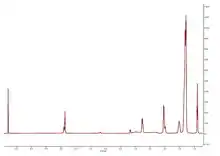Oleylamine
Oleylamine is an organic compound with a molecular formula C18H35NH2.[1] It is an unsaturated fatty amine related to the fatty acid oleic acid. The pure compound is a clear and colorless liquid. Commercially available oleylamine reagents[2][3][4][5][6] vary in color from clear and colorless to varying degrees of yellow due to impurities. The major impurities include trans isomer (elaidylamine) and other long chain amines with varying chain lengths.[7] Minor impurities include oxygen-containing substances such as amides and nitroalkanes.[7]
 | |
| Names | |
|---|---|
| Preferred IUPAC name
(9Z)-Octadec-9-en-1-amine | |
| Other names
9-Octadecenylamine 1-Amino-9-octadecene, (9Z)-Octadecene | |
| Identifiers | |
| ChemSpider | |
| ECHA InfoCard | 100.003.650 |
PubChem CID |
|
| UNII | |
CompTox Dashboard (EPA) |
|
| Properties | |
| C18H37N | |
| Molar mass | 267.493 g/mol |
| Appearance | colorless oil, yellowish when impure |
| Density | 0.813 g/cm3 |
| Melting point | 21 °C (70 °F; 294 K) |
| Boiling point | 364 °C (687 °F; 637 K) |
| Insoluble | |
| Hazards | |
| NFPA 704 (fire diamond) | |
| Flash point | 154 °C (309 °F; 427 K) |
Except where otherwise noted, data are given for materials in their standard state (at 25 °C [77 °F], 100 kPa).
Infobox references | |
Chemical reactions
Oleylamine reacts with carboxylic acid to form its carboxylate salt through an exothermic reaction.[8][9] Its carboxylate salt can further condensate into amides through the loss of one water molecule. In the presence of acetic acid, oleylamin formes with DNA insoluble complexes with the radii of the particles equil 60–65 nm.[10]
Uses
Commercially, it is mainly used as a surfactant or precursor to surfactants.[11]
It has also been used in the laboratory in the synthesis of nanoparticles.[12][13] It can function both as a solvent for the reaction mixture and as a coordinating agent to stabilize the surface of the particles. It can also coordinate with metal ions, change the form of metal precursor and affect the formation kinetics of nanoparticles during the synthesis.[13]
Safety
Oleylamine has an LD50 (Intraperitoneal) of 888 mg/kg in mice, however note that it is listed as a level 3 health hazard on the NFPA diamond, so it should be handled with caution.
Characterization
Oleylamine can be characterized using MS, HNMR, CNMR, IR, and Raman. Each technique shows distinct peaks in various regions.[14]

See also
References
- Pubchem. "Oleylamine". pubchem.ncbi.nlm.nih.gov. Retrieved 2019-03-10.
- "Oleylamine, technical grade 70% (Sigma-Aldrich)". Retrieved March 10, 2019.
- "Oleylamine, ≥98% primary amine (Sigma-Aldrich)".
- "Oleylamine, min. 95% (Strem Chemicals)". Retrieved March 10, 2019.
- "Oleylamine, min. 70% (Strem Chemicals)". Retrieved March 10, 2019.
- "Oleylamine, approximate C18-content 80-90% (Acros Organics, catalog number 12954)". Retrieved March 10, 2019.
- Baranov, Dmitry; Lynch, Michael J.; Curtis, Anna C.; Carollo, Alexa R.; Douglass, Callum R.; Mateo-Tejada, Alina M.; Jonas, David M. (2019-02-26). "Purification of Oleylamine for Materials Synthesis and Spectroscopic Diagnostics for trans Isomers". Chemistry of Materials. 31 (4): 1223–1230. doi:10.1021/acs.chemmater.8b04198. ISSN 0897-4756.
- Yin, Xi; Wu, Jianbo; Li, Panpan; Shi, Miao; Yang, Hong (January 2016). "Self-Heating Approach to the Fast Production of Uniform Metal Nanostructures". ChemNanoMat. 2 (1): 37–41. doi:10.1002/cnma.201500123.
- Almeida, Guilherme; Goldoni, Luca; Akkerman, Quinten; Dang, Zhiya; Khan, Ali Hossain; Marras, Sergio; Moreels, Iwan; Manna, Liberato (2018-02-27). "Role of Acid–Base Equilibria in the Size, Shape, and Phase Control of Cesium Lead Bromide Nanocrystals". ACS Nano. 12 (2): 1704–1711. doi:10.1021/acsnano.7b08357. ISSN 1936-0851. PMC 5830690. PMID 29381326.
- Zaborova, O. V.; Voinova, A. D.; Shmykov, B. D.; Sergeyev, V. G. (2021). "Solid Lipid Nanoparticles for the Nucleic Acid Encapsulation". Reviews and Advances in Chemistry. 11 (3–4): 178–188. doi:10.1134/S2079978021030055. ISSN 2634-8276. S2CID 246946068.
- Karsten Eller, Erhard Henkes, Roland Rossbacher, Hartmut Höke "Amines, Aliphatic" in Ullmann's Encyclopedia of Industrial Chemistry, Wiley-VCH, Weinheim, 2005. doi:10.1002/14356007.a02_001
- Mourdikoudis, Stefanos; Liz-Marzán, Luis M. (2013-05-14). "Oleylamine in Nanoparticle Synthesis". Chemistry of Materials. 25 (9): 1465–1476. doi:10.1021/cm4000476. ISSN 0897-4756.
- Yin, Xi; Shi, Miao; Wu, Jianbo; Pan, Yung-Tin; Gray, Danielle L.; Bertke, Jeffery A.; Yang, Hong (5 September 2017). "Quantitative Analysis of Different Formation Modes of Pt Nanocrystals Controlled by Ligand Chemistry". Nano Letters. 17 (10): 6146–6150. doi:10.1021/acs.nanolett.7b02751. PMID 28873317.
- "Oleylamine(112-90-3) 1H NMR".
